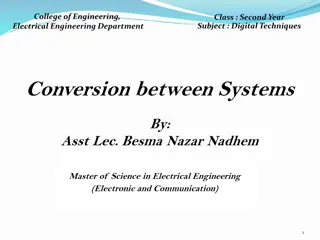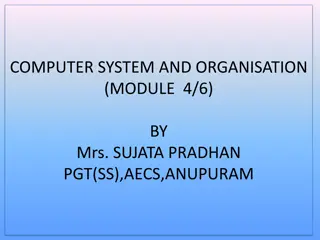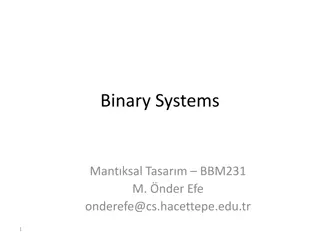Understanding Binary Number System and its Applications
Explore the world of binary numbers with insights on what binary is, its significance in computing, conversion methods between binary and decimal, hexadecimal number system, and binary arithmetic operations. Dive into the foundations of digital communication through the language of zeros and ones.
Download Presentation

Please find below an Image/Link to download the presentation.
The content on the website is provided AS IS for your information and personal use only. It may not be sold, licensed, or shared on other websites without obtaining consent from the author. Download presentation by click this link. If you encounter any issues during the download, it is possible that the publisher has removed the file from their server.
E N D
Presentation Transcript
Binary By Abirami, Fatima, and Lily 1
Intro to Binary 01 2
What is Binary and why is it used? - A language spoken by computers entirely composed of 0s and 1s. It s used because the way a computer works resembles rows and rows of switches- on being 1, and off being 0. Each binary number has a combination of four 0 or 1 digits, and each combination varies between what letter or number it represents. - - 3
Binary To Decimal 02 Abirami Tilak 4
Binary to Decimal Heavily relies on powers of two 0 0 0 0 1 1 1 1 27 26 25 24 23 22 21 20 X X X X 8 + 4 + 2 + 1 = 15 0 s on the left of the number don t count to the number 5
Decimal to Binary Like binary to decimal, heavily relies on powers of two 27 26 25 24 232221 20 X X X 16 + X X 2 + 1 = 19 16 is the biggest power of 2 in 19 0 0 0 1 0 0 1 1 19-16=3 6
03 Hexadecimal Abirami Tilak 7
What is Hexadecimal? Hexadecimal is another type of number system Base 16 Can contain 0-9 and A-F Each letter is equivalent to half a byte 8
Hexadecimal to Decimal Heavily relies on powers of 16 instead of 2 3 2 A 3*162 2*161 10*160 768 + 32 + 10 = 810 9
Binary to Hexadecimal Ex. 100100101100 1001 0010 1100 9 2 C 10
Hexadecimal to Binary Similar to Binary to Hexadecimal 7 5 D 0111 0101 1101 11
Addition and Subtraction in Binary 04 Liliana Ng 12
Intro to Binary Math: Just like normal decimal math + - Only 0 s and 1 s! 13
0+0= 0 +1 Addition: (+) 2 0+1= 1 Start with single digits 8 + 13 4 1+1= 10 1+1+1= 11 __________________________________ 1 In decimal math, when the sum of two # s>9, the 10s digit carries over +1 +1 +1 0110 + 1110 _______________________ 1 0 1 Carrying causes the first digit to be a 0, and the next adds 1 0 0 14
+1 0-0= 0 3 4 Subtraction: (-) 1-0= 1 2 - 17 __________________________________ 2 Start with single digits (again) 1-1= 0-1=01 0 5 When the difference of two numbers in the same digit <0, you have to take from the digit on the left +1 0 11011 0110 ___________________________ 1 0 1 - Like addition, subtraction in binary works the same way as decimal 0 1 15
Multiplication and Division in Binary 05 Fatima Mulyono 16
101 100 _______________________ 0 1 + 10000 _________________________________ 10100 Multiplication: ( ) Just normal multiplication, the product should also be written in binary 0 17
Division: () 0 0= Not defined Start with single digits Division with big numbers is harder 1 0= Not defined 0 1= 0 1 1= 1 18
05 Negatives Liliana Ng 19
Negatives What defines a negative number? A number and it s opposite have to add up to 0 Ex. 3+(-3)=0 Ex. 6+(-6)=0 Thinking backwards 1001 +0110 __________________________ 1111 100 011 0110 1 0 +1 The process: 1. Flip the 1 s & 0 s 2. Check: If those two numbers are added, you should get all 1 s 3. Add a 1 to the rightmost digit 4. new number are added, it should have a one on the left side, and the rest should be zeros Check: If the original number and the 1001 +0111 __________________________ 10000 = 0111 5. In the sum you just added, the left 1 doesn t actually matter, you re done! 20
06 ASCII Fatima Mulyono 21
What is ASCII? - The first major character encoding standard for data processing An acronym that stands for American Standard Code for Information Interchange Used to represent text in computers ASCII-encoded data can be translated into 128 various alphabetic, numeric or special additional characters and control codes You can convert ASCII code into binary! - - - - 22
Converting ASCII to Binary 1. Get your character (number, letter, or additional character) 2. Use an ASCII table to find the binary conversion of your character or 1. Get your character (number, letter, or additional character) 2. Find the decimal code of your character from an ASCII table 3. Convert that decimal code to its binary code Note: in order to convert binary to ASCII, just reverse the system! 23
Thanks! Any questions? Feel free to ask afterwards! CREDITS: This presentation template was created by Slidesgo, and includes icons by Flaticon and infographics & images by Freepik 24























